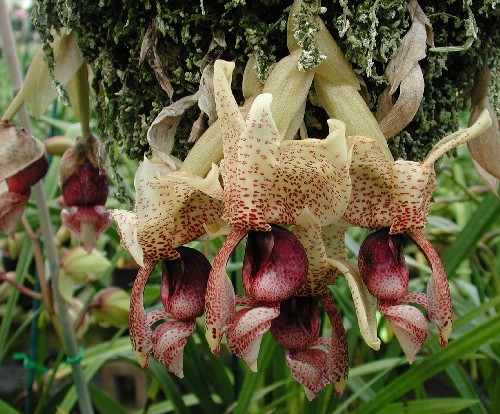
Native to Ecuador, Peru, and coastal Brazil
(Rio de Janiero, Sao Paolo, Pernambuco, Parana, Santa Catarina & Rio Grande do Sul)
Edited 31 May 2007
© Nina Rach


This is the type species for the genus Stanhopea; an excellent choice, as it is an extremely fragrant and visually impressive species (insignis is Latin for "showy"). It is native to the mountains of Rio de Janiero, Sao Paulo, Parana, Santa Catarina, and Rio Grande do Sul, and grows in intermediate conditions with high humidity, and a cool, dry winter rest.
Stanhopea insignis arrived in the U.K. from D. Lochart at Trinidad Botanic Garden in 1818, and was described in 1829 by English botanist Sir Wm. Jackson Hooker (1785-1865) in Botanical Cabinet; Consisting of Coloured Delineations of Plants from all Countries [Edited by Loddiges]. This was based on information from the American botanist Charles Christopher Frost (1805-1880;
Bio).
The image at right is Plate 2948 from Curtis' Botanical Magazine, published in 1829. The original is approximately 8"x10" and has two folds (a double plate). Plate 2948 (single, 5"x8", not pictured) is also of interest; it depicts a closeup of the flower. This rendering looks remarkably similar to Stanhopea napoensis from Ecuador. Although this species is sometimes listed for Ecuador, it is not found in the
Checklist of Vascular Plants of Ecuador (CVPE).
.

.
.
The image at left is Stanhopea insignis 'Santa Barbara', a clone with particularly striking markings, ruby red spotting on sepals and petals and a wash over the hypochile. This grex tends to bloom in the late fall, Oct-Nov, bearing 2-3 large flowers per inflorescence. Note the beautifully rounded hypochile, the spotted and winged column, and the prominent bracts on the short inflorescences.
This species prefers intermediate to cool conditions, shaded and humid. It will not tolerate wet roots. Photo kindly provided by
Joe Daugherty, website: http://www.orchids.org/about/josephd.html.
.
.

.
.
The image at right shows a plate from Edwards' Botanical Register, circa 1830's, published by James Ridgway, 169 Piccadilly, London. The original hand-colored engraving is 10 1/2" by 9 1/4" and is titled the "Noble Stanhopea."
.
Sydenham Teak Edwards (1769-1819) trained under William Curtis (1746-1799) and produced most of the engravings for Curtis' Botanical Magazine until 1815. In that year he started his own publication The Botanical Register, and produced engravings for it until his death in London, 8 February 1819 at the age of 51. The Botanical Register was published monthly between 1815-1828, and was then continued as Edwards' Botanical Register from 1828-1847.
.
.

The image at right of a 19th century lithograph was published in Ghent, Belgium, by Jean Linden (1817-1898), in 1889, part of the first series of his famous work on orchids, "Lindenia - Iconographie des Orchidees." Known as the "Lindenia", it was originally published in two parts; the first series of 10 volumes was published from 1885-1894 and the second series of 7 volumes was published from 1895-1901. The lithographs and accompanying text were printed on high quality heavy paper stock, and measure approximately 10 1/2 inches by 13 3/4 inches.
Lindenia - Iconography of Orchids; was re-published in 1993, comprising 2300 pages in five volumes, with 814 color plates.
.
There seem to be several different color forms of Stanhopea insignis. Some are cream to yellow with very little spotting across the sepals and petals, and devoid of spotting on the epichile and horns. In this palest form, the color seems to be limited to the interior and exterior back of the hypochile, with some markings on the column. Pale forms seem to come from Brazil. The intensity of color can run all the way to the heavily saturated coloration seen in the clone 'Santa Barbara,' with heavy spotting on sepals, petals, and all parts of the lip.
Printed References:
F.C. Hoehne (1949) Iconografia de Orchidaceas do Brasil. Sao Paulo: Secretaria de Agricultura, 301 illustrated pages, followed by 300 full-page plates. [Gongora bufonia (Pl. 186), nigrita (Pl. 187); Stanhopea candida (Pl. ), eburnea (Pl. 179), graveolens (Pl. 177 color), guttulata (Pl. 180), insignis (Pl. 176), oculata (Pl. ), Randii (Pl. )]
Rudolf Jenny (Dec. 2003) "The Genus Stanhopea. Part 1: S. anfracta to S. napoensis," in: Caesiana no. 21, Supplement. 200 color photos, 160 p., Italian/English, covers 32 species.
Myron Kimnach (Sept. 1978) "The Cultivation of Stanhopea and Its Allies," in: AOS Bull. 47(9): 784-794.
Lucien Linden and Emile Rodigas (Eds.) (1895-1906; Series 2, 7 vol.) Lindenia: Iconographie des Orchidees. Ghent, Belgium: Jean Jules Linden. [six Stanhopeas: eburnea; insignis; moliana; wardii var. venusta (now anfracta)]
Jim and Barbara McQueen (1993) Orchids of Brazil. Timber Press, 200 pages, 300 illustrations. [includes Stanhopea insignis, Stan. oculata]
"General information to identify and grow more than 300 Brazilian orchid species. For each one, a color photograph, information on origin, growing, and on flower measurements."
Guido F.J. Pabst and F. Dungs (1977) Orchidaceae Brasiliensis. Book [Band] II. Hildesheim: Brucke-Verlag Kurt Schmersow. [113. Stanhopeas (nos. 1678-1684), in color: Stanhopea guttulata, insignis (2), lietzei (4), oculata, candida (randii), grandiflora (eburnea); Stanhopeas in text, no color: Stanhopea leucochila, oculata]
Henry Teuscher (Sept. 1973) "Collector's Item: Stanhopea insignis," in: AOS Bull. 42(9): 790-793.
Online References:
International Plant Names Index [IPNI],
www.ipni.org.
Native orchids of Rio Grande do Sul, Brazil
Photo of Stanhopea insignis from Bergstrom Orchids - site temporarily down?
Photo of Stanhopea insignis by Dennis de Silva, pale form
Photo of Stanhopea insignis by Alberto Katsurayama, pale form [Alberto Orquideas]
Photo of Stanhopea insignis by Astor Viana Jr., with particularly deep red markings on lip and column.
Photo of Stanhopea insignis by Jitze Mud, yellow intermediate form [Holland]
Photo and habitat info by Max Peixoto, SE Atlantic forest of Brazil
Orchids flowering in the Brazilian state of Minas Gerais - blooms in January, February, April, May, June, December.
AOS award to this species:
Stanhopea insignis 'Hana Imogawa' HCC/AOS (78 pts)
6/13/83, Los Angeles, CA
Exhibitor: Donald Tanahashi, Los Angeles
